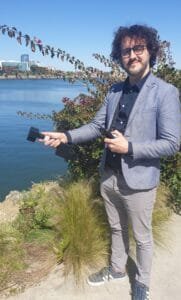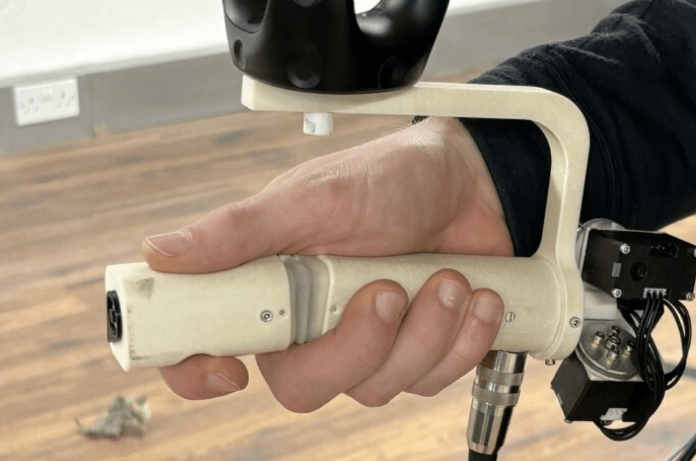Imagine navigating an unfamiliar space with no reliance on vision, guided instead by touch. For individuals with visual impairments, this scenario is now a promising reality, thanks to a remarkable device called Shape. Developed by researchers at Imperial College London in partnership with MakeSense Technology and the charity Bravo Victor. Shape is redefining mobility and independence. Harnessing the power of haptic perception—our innate ability to understand shapes and spatial information through touch—this device is poised to transform the way people with visual impairments explore the world.
How Does ‘Shape’ Work?
At first glance, Shape resembles a simple torch. However, it’s a sophisticated navigation tool that uses tactile feedback to direct users. The device bends to indicate where a person should move and straightens when they are facing the correct direction. Unlike other navigation aids that rely on sound or vibrations, this device capitalizes on the natural ease with which humans interpret shapes through touch.
Dr. Ad Spiers, the lead researcher from Imperial’s Department of Electrical and Electronic Engineering explains the innovation: “Humans have an innate ability to feel and interpret shapes through our hands, with very little concentration. Exploiting this allows us to create a device that is simple to learn and isn’t tiring to use.”
This simplicity is precisely what sets Shape apart—it reduces the cognitive load typically required by other devices, making navigation not only intuitive but also less mentally taxing.
Moving Beyond Traditional Tools
Currently, people with visual impairments often rely on white canes or guide dogs. While effective, these aids have significant limitations:
- White canes provide information by identifying obstacles, focusing on where not to go rather than offering guidance on where to move.
- Guide dogs, though reliable, require extensive training and can cost thousands annually to maintain.
Recent technological advancements, such as auditory and vibration-based navigation aids, have also presented challenges. Audio interfaces may interfere with the user’s ability to hear surrounding sounds—critical for safety and awareness. Similarly, vibration-based devices can cause discomfort and distraction over time, leading to frustration for the user.
Shape addresses these shortcomings with its innovative approach. By relying on touch rather than sound or repetitive vibrations, it offers users precise and clear guidance without compromising their sensory engagement with the environment.
Shape: Proven Performance
The effectiveness of this innovative device was rigorously tested in a study published in Nature Scientific Reports. Researchers designed a 3D virtual reality (VR) environment to evaluate how well individuals with visual impairments could locate targets using Shape, vibration technology, and natural vision.
The results were nothing short of remarkable. The study compared the results of 10 participants with visual impairment and 10 sighted participants.

- Participants with visual impairments performed just as well using Shape as sighted participants relying solely on vision.
- Shape significantly outperformed vibration technology, with users finding targets faster and preferring the tactile feedback of Shape over vibrations.
- Feedback showed that Shape’s intuitive design was a key factor in its success, with participants describing it as more comfortable and less distracting than existing technologies.
Dr. Spiers emphasized the significance of these findings: “The exciting thing about this study is we’ve managed to demonstrate that Shape can help people with visual impairment perform a navigation task as well as sighted people. This is something that we haven’t seen before with other navigation devices.”
The Road to Real-World Application
Although the controlled environment of the study provided consistent conditions for testing, researchers acknowledge that real-world scenarios present unique challenges. Outdoor navigation involves dynamic factors such as weather, obstacles, and multiple moving targets, which could influence the device’s performance.
To address these challenges, MakeSense Technology, co-founded by Dr. Robert Quinn, is refining the Shape device to include advanced spatial artificial intelligence and computer vision. These updates aim to enhance its functionality in complex environments, making it even more reliable for daily use.
Dr. Robert Quinn, CEO of MakeSense Technology expressed his optimism for the future: “The impressive results from this study demonstrate the enormous potential of this technology to make life-changing improvements in mobility for people with visual impairment.” MakeSense is targeting late 2025 for the release of its first commercially available product.
A New Era of Navigation
Shape isn’t just a tool; it’s a vision of greater independence and freedom for individuals with visual impairments. By offering a navigation method that is intuitive, non-invasive, and efficient, it fills a crucial gap left by traditional aids.
This innovative device could revolutionize the way people with visual impairments experience the world. It promises not only to improve mobility but also to foster confidence and autonomy. As testing moves into real-world environments, Shape is set to become a game-changer, paving the way for a future where navigation is no longer a barrier but a seamless part of daily life.
Could Shape be the ultimate answer to enhancing navigation for those with visual impairments? For those who rely on touch as their primary guide, the answer might just be a resounding yes.

